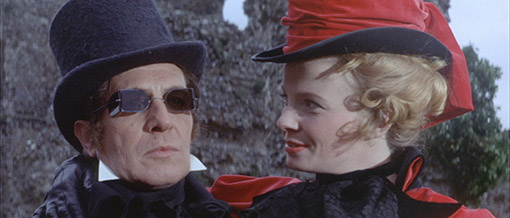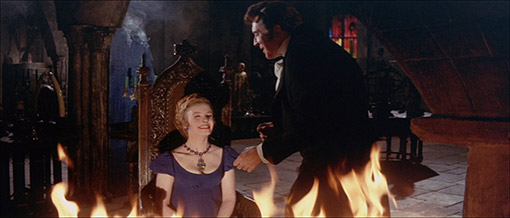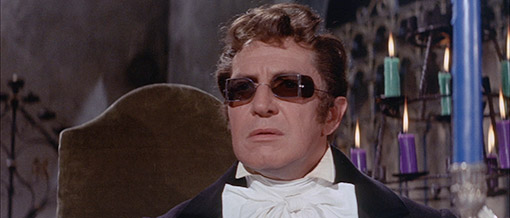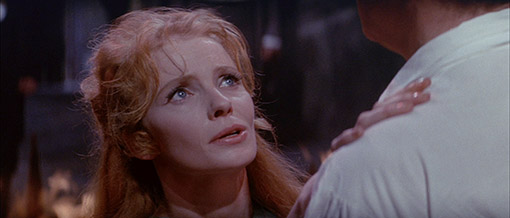|
'That she loved me I should not have doubted; and I might have been easily aware that, in a bosom such as hers, love would have reigned no ordinary passion. But in death only, was I fully impressed with the strength of her affection.' |
|
Ligeia – Edgar Allan Poe |
The Tomb of Ligeia was the last of Roger Corman's adaptations of Edgar Allan Poe stories and for some it's the best, despite being archetypal of the series in a number of ways. It certainly marked a change of direction for the cycle, moving it out of the studio and into the Norfolk countryside. And yes, that's Norfolk in England, not the one in Virginia to which the original gave its name. This was Corman's second Poe film to be shot in the UK after Masque of the Red Death, which I personally hold in even higher regard than Ligeia. Either way, there's no denying that The Tomb of Ligeia is a seriously classy piece of work and a damned fine way for the series to bow out.
Here Vincent Price plays Verden Fell, who in the pre-title sequence is seen burying his late wife Ligeia in the grounds of the ruined Abbey in which the couple lived. The service is interrupted by a self-righteous toad of a priest who claims that as a non-Christian she cannot be buried on consecrated ground. Up yours, God boy. In a double-barrelled portent of things to come, a black cat jumps onto the coffin and prompts Ligeia's eyes to spring open (the coffin has one of those windows that allow you to see the face of the departed, like that one the poor bugger who was buried alive in Vampyr was carried to the churchyard in). Surprisingly, Verden is the only one who sees nothing sinister in this. "A nervous contraction," he calmly explains, opening the window and closing Ligeia's eyes with his fingers in that way people probably only do in films.

Following the title sequence – impressive as ever – we're treated to the sight of a band of red-coated scumbags galloping through the countryside on the heels of a fleeing fox, the unthinkable in pursuit of the uneatable, as Oscar Wilde succinctly described them. One of the group, Lady Rowena Trevanion don't you know, has broken off to explore the grounds of a familiar-looking ruined Abbey and has enticed cocksure young Christopher Gough into following her. When the two become separated, Rowena happens upon Ligeia's gravestone, on which a jet black cat is perched. As she walks forward to stroke it she's given the fright of her life when Verden appears out of nowhere, prompting her to scream and faint on the spot. It may seem a bit of a film girlie thing to do, but the manner of Verden's appearance is enough to give anyone a start. Dressed in funereal black and wearing a stern expression and a set of angular sunglasses that would wind up the Devil himself, he seems to materialize out of nowhere, the startling nature of his arrival accentuated by an accelerated camera move that practically throws us at his feet. It's a trick Corman will reuse later to similarly startling effect, damn him.
Christopher comes running (I'll get to him in a minute) and it turns out that he and Verden are old acquaintances, though somehow I can't imagine even a young and happy Verden being part of the horsey set. And Ligeia had a pet fox, the very one that these bastards were chasing across the fields. When Rowena comes to and is introduced to Verden, something unexpected and rather interesting happens. Instead of nervously recoiling (she's still lying on the ground at this point, and Verden is rather tall), she addresses him with an expression that suggests that she'd rather like to give him a sexual seeing-to of the like he's probably never envisioned in his wildest fantasies. Exactly what actress Elizabeth Shepherd drew on from her own life to produce such a look is probably something we shouldn't ponder on. Give the lady some privacy.

When Verden picks her up and carries her into what we can presume is the only inhabitable remains of the abbey, the deal is sealed. Rowena wants Verden, and a short while later is cheerfully telling her father – a landowning twit of the highest order who introduces himself to Verden by waving the carcass of Ligeia's pet fox at him – that she intends to marry this mysterious recluse. She's not even dissuaded when she drops in unexpectedly on Verden and he tries to strangle her under the mistaken belief that she's…well…who, exactly? And then there's that cat, which really seems to have taken a dislike to Rowena. It scratches her face when she and Verden make moves to kiss, and later nabs Verden's sunglasses (his spare ones, as it turns out) and leads Rowena on a dangerous trot up to the top of the bell tower. But it all backfires on this sinister and probably possessed feline when Verden comes to Rowena's rescue and, in a single beautifully timed edit, is then shown accompanying her out of the church on their wedding day. And they all lived happily ever after. Yeah, right.
That the marriage has its problems is signalled early on by the fact that these two love birds are sleeping in different rooms and that Verden seems to be preoccupied, and not with the Lady Rowena. And believe me, if this woman was after your body and soul, the chances are that you'd surrender it in a heartbeat if you were compos mentis. The fair haired Rowena is further rattled when she she hears her hairbrush being used just a few feet from her bed and then finds it riddled with black hairs. Something untoward is clearly going on here. It's about to get worse. At a dinner party to which Christopher and Rowena's buffoon of a father have been invited, Verden is talked into giving a demonstration of mesmerism, a subject with which he has become fascinated. He elects to hypnotise Rowena, and all is going well until her voice drops a couple of octaves and she becomes a vessel for the late Ligeia to remind Verden that she was and always will be his wife. Taken to bed to rest from her trauma, she wakes from a disturbing dream to find the carcass of Ligeia's fox lying on top her and a saucer of milk beside her bed.

From here on in it's all downhill for Rowena and Verden, and it's left to Christopher to rescue Rowena from a fate worse than, well, marrying him if the truth be told. Much as I love the film, when it comes to the menfolk my sympathies always remain with Verden, who is not inherently nasty but the victim of his late wife's malevolent spirit. Christopher, on the other hand, is the sort of self-important cock that the so-called upper classes seem to breed in droves and send off to Eton to prepare for governmental office. Rowena deserves far better, and would have had it had the vindictive Ligeia not reached out from beyond the grave and messed it all up.
But my issues with Christopher are mine alone [they're not, actually – Slarek], and even for me this a minor irritation in an otherwise gripping, unsettling and imaginatively told tale. Rowena herself is a rare example in the Corman Poe cycle of a strong central female character and she is played with such confidence by Elizabeth Shepherd that for whole stretches of the film Price becomes a supporting player, though when he does control a scene he really makes an impression. Colin Southcott's dark hued art direction (which is peppered with bits of set construction borrowed from the far bigger budgeted Becket) infuses the abbey with a very real air of melancholic menace, which hits a creative peak with Rowena's ascension of the dark walled bell tower, which is underscored by a portentous monologue delivered by Verden to Christopher in the brighly contrasting exterior of the Abbey grounds.
Aided no end by a literate script from a then newcomer Robert Towne – whose later credits include The Last Detail, The Parallax View and Chinatown – Corman also delivers a couple of moments of quite splendid grotesque. The first occurs at the climax of a creepily handled dream sequence when Verden is transformed into Ligeia when Rowena kisses him, the second when Rowena encounters Ligeia's preserved body and... no, I'll let you tumble into that one yourself. And while this may make me sound like an unobservant idiot, so distinctively styled and performed are the characters of Rowena and Ligeia that on my first viewing of the film some years ago I failed to realise that they were both played by Elizabeth Shepherd until the end credits rolled (in my defence I will state that my viewing companion of the time was similarly fooled).

In stretching beyond the confines of the studio, Corman makes The Tomb of Ligeia feel like a bigger budgeted film than it undoubtedly was, while Arthur Grant's mobile camera and Alfred Cox's tight editing keep the incident-packed narrative moving as briskly as you'll find anywhere in the Poe cycle. The black dressed and stern faced Price in those angular sunglasses remains one of the most iconic images of the series, and has been used to headline a number of magazine articles and features on Corman or his Poe adaptations, and was even used by the BFI to headline a season of Corman films some years ago (almost every one of which this site's editor attended, I am told). And given that this was Corman's final Poe adaptation, it seems only fair that he should, in a final act of symbolic destruction before moving on to pastures new, once again conclude the story by burning the abbey to the ground.
As with the other discs in this set, the master for this transfer was created by MGM and further refined by the good people at Deluxe in London, and like those other transfers it looks terrific. That the exteriors look great is to be expected, but the transfer also does well by the darker interiors, picking up all of the fine detail in the sets and the costumes, at least when they are not deliberately cast into shadow. Despite the dark-walled interiors, the colour palette is one of the richest in this Blu-ray set, and really pops on brighter hues, such as the red coats of the horrible huntsmen and some brightly coloured candles that I'll just bet were specifically selected for how they'd look on film. Dust and dirt has been almost completely removed, and I only spotted the odd small scratch here and there, usually affecting areas of the image that it would be hard to digitally remove.

The Linear PCM mono track has some inevitable range restrictions (no booming bass here), but is in far better shape than the soundtracks of a good many other restorations of more expensive films of the period. There's no trace of damage, and no distracting background hiss or crackle.
As with the other discs in this set, there's also an isolated music and effects track, which is rather fun to put on during the dinner party sequence, when all you can hear are faint plate-poking noises.
Optional English SDH subtitles are also available.
Audio Commentary with Roger Corman
The always lovely voice of director Roger Corman takes us on an unhurried but rewarding trip through the making of the last of his Poe adaptations, which he was determined from the start should have a different feel to its predecessors. It's a screen-specific commentary, and despite some sizeable pauses Corman provides info on almost every scene here, on the way discussing the actors, the locations, the set dressing, his fondness of framing and foreground composition, the use of wide-angle lenses to visually enlarge the scale of sets, and a fair amount more. He reveals that he enjoyed shooting in England and praises the crew, but like so many visiting American directors was a little mystified by the daily scheduled tea breaks. My favourite bit comes towards the end when, after claiming that this was one Poe film which did not conclude with the house burning down, he reacts with surprise when the climactic fire breaks out. "Wait a minute," he says, "don't tell me I burned the house down again in this one. I thought I'd stopped doing that!"
Audio Commentary with Elizabeth Shepherd
Whether this was originally intended as an audio commentary or recorded by a film writer for reference purposes is a hard one to call. Allow me to explain. Audio commentaries are usually recorded under studio conditions, with the participants seated in front of a screen on which the film plays out and armed with microphones and headsets, through which they can monitor the soundtrack of the film and comment on the action, and their voices are mixed with the film soundtrack later to better balance the levels. The one here sounds as if it was recorded on some sort of lo-fi portable device in somebody's living room as the film plays out on a TV in the background. Quite who was responsible for the recording is not clarified here, but his voice can be heard (slowly) asking questions of actress Elizabeth Shepherd and making comments about the film. Well, sort of. The recording level is low and you'll need to push the volume up on your amp or TV if you want to clearly make out what's being said, and even then there are a few times when the interviewer's mumbles are swallowed up by the background noise. There are also a fair few sizeable gaps when you'll only have the regular film soundtrack to listen to, but stick with it because there's plenty of good stuff here, as Shepherd recalls her work on the film with the sort of enthusiasm that makes me wish I'd worked on it too. She discusses the shooting of specific scenes, the collaborative nature of the project, how one of the make-up effects was done, playing gothic with passion, and more. She is also prompted to deconstruct some of the thematic elements, which she does rather well.

Paul Mayersberg Interview (24:26)
Later to make his name of a screenwriter of some note (The Man Who Fell to Earth, Eureka, Merry Christmas Mr. Lawrence) and occasional director, here Paul Mayersberg recalls how he came to be hired by Corman to fulfil a number of roles on the film, including checking Robert Towne's screenplay for appropriately anglicised language and shooting the honeymoon sequence with a loaned camera and two friends doubling as the leads. He describes working on the film as an incredible learning experience that eventually paved his road to Hollywood, and reveals that Corman's film structure bible was Joseph Campbell's The Hero With a Thousand Faces. Well, you don't say.
David Tringham Interview (8:15)
The film's assistant director recalls how he came to work on the film (a phone call, no interview, just turn up and get started) and the sheer speed with which Corman worked, running from setup to setup and quickly abandoning a shot if it couldn't be set up quickly enough, all of which Tringham regarded as a refreshing change from the norm. He talks about the problem of working with cats (the first one ran away after being deliberately scared for a reaction shot) and remembers Vincent Price being the best thing about working on the film.
Bob Jordan Interview (7:41)
The film's clapper-loader (look it up if the term is unfamiliar) outlines how he first met cinematographer Arthur Grant, with whom he worked for many years, and provides some technical background on the difficulty in shooting in scope at a time before film cameras had live video feeds. The shooting of the fire at the film's climax, he assures us, was 'scary'. I'll bet.
Kenneth V. Jones Interview (6:19)
The film's composer talks about being given full responsibility for the score and creating a specific theme for the cat that could be 'twisted and turned'. This is actually a far shorter interview than the above running time suggests, and has been padded out by including the final two-and-a-half minutes of the film itself. Not completely sure why, but as a result I'd definitely avoid watching this before the main feature.
Perhaps the most sophisticated of Corman's Poe adaptations and one that benefits no end from a strong female lead and the breathing space provided by the expansion into outdoor settings. As ever, the presentation is exemplary, with a terrific transfer and some excellent extra features. Superb.
|